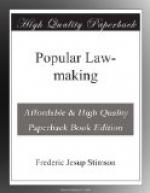That there has been a vast deal of interference, or attempted interference, with these principles in modern American legislation goes without saying. The motive or force behind such legislation has pretty clearly two sources: First, the behest or desire of the “Labor interest” or organized labor, the trades-unions themselves; and when we analyze these and their constituents we shall find that it really means only mechanical or industrial labor, not farm or agricultural labor (which is still in numbers the greatest body of labor in the United States), nor, as yet, domestic service labor, nor what the census calls “personal service,” which is probably next in numerical importance, nor clerks; it is a comparatively small class in numbers, this class of skilled mechanical or manufacturing labor, that has brought about this immense mass of legislation of our modern States aimed at improving their own labor conditions; and which therefore, necessarily perhaps, interferes with personal liberty as to the labor contract, or, at least, seeks to regulate it.
The other great influence is rather a motive than a source; we may call it, for want of a better word, the sentimental or the altruistic motive—the moral motive; the forces behind it being mainly of a religious or moral origin, philanthropists, students of ethics, and recently, to a great extent, the women and the women’s clubs. The activity of these great forces may be clearly traced through the nineteenth century. It first belonged to the antislavery movement, which directly and historically led to the women’s suffrage movement, owing to the fact that at a great antislavery convention in England a woman delegate was refused a seat upon the platform, while her husband, a comparatively obscure person, was recognized as the leading representative from America; and ending of late years in the prohibition movement, to regulate or prohibit the trade in intoxicating liquors, and to exclude the canteen from the army. But in the latest years, in these last very few years indeed, the forces of this category have devoted a large proportion of their “categorical imperative” to labor conditions and the labor contract.




